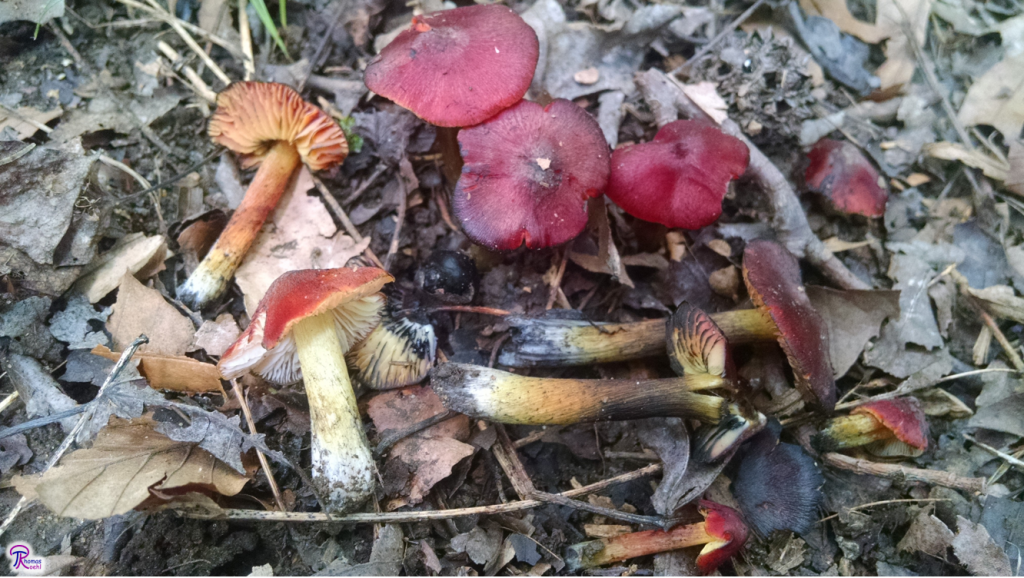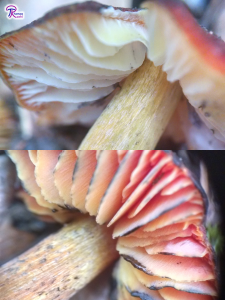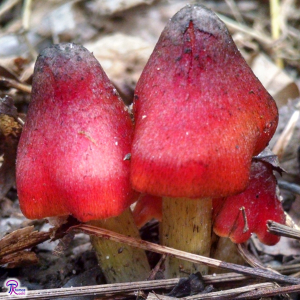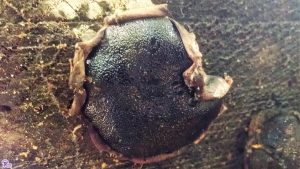#057: Hygrocybe conica, The Witch’s Hat

The Witch’s Cap, Hygrocybe conica, is a red, orange, and yellow waxcap that discolors blackish. In the center of this photo, a small Witch’s Cap mushroom has turned completely black.
Welcome back to creepy fungus month! I’m starting off this month with a mushroom that has a creepy name but is always fun to find: The Witch’s Hat. Hygrocybe conica gets its common name from the conic shape of its cap, its orange to red color, and its tendency to bruise strongly black. Actually, this last feature is probably the most important; when the mushrooms turn completely black they really do look like tiny hats for witches! The Witch’s Hat grows on the ground in a variety of habitats and mycologists are not sure what its ecological role is.1,2
Description
The Witch’s Hat is a small umbrella-shaped agaric whose cap is 1 to 9cm across and whose stipe is 3 to 10cm tall. Young specimens of this mushroom truly are beautiful. The bright red to orange pileus nicely compliments the lighter, orange to yellow stipe. However, H. conica mushrooms quickly develop blackish discolorations and end up looking rather dingy.1,3,4
These blackish discolorations are actually the most useful feature for identification purposes. Witch’s Hat mushrooms turn black on their own as they age or as a result of injury. This bruising reaction is slow but strong. Older specimens are often blackened on their edges and broadly over the middle of the stipe, although some can turn almost completely black. Only a couple other closely related species exhibit this characteristic, so finding black stains greatly simplifies the identification process.1,3,4
When young, the pileus is conical with a curved top and edges that curve slightly inward. The pileus opens up as the mushroom matures to become broadly conical to convex, although it retains a point at its center. Although the margin is smooth, it usually develops irregular lobes. Fresh caps have a sticky texture, but that feature is quickly lost as the pileus dries out. Once dried out, the pileus is smooth or streaked with fine hairs. The pileus is bright red to orange and fades to orange/yellow with age and/or develops black stains.1,3,4

The gills of the Witch’s Cap start out white (top) but eventually turn yellow and then orange (bottom) before staining black.
H. conica belongs to a group of mushrooms known as the waxcaps (Hygrophoraceae, FFF#182). Like the other members of this group, its gills have the consistency of soft wax when rubbed between the fingers. The gills are only slightly attached to the stipe and appear nearly free from it. When young, the gills are white to yellowish in color but they gradually become yellowish and then orange as the mushroom ages. In older mushrooms, the gill edges are often stained black and there can be blackened areas on the gill faces as well. The gills drop spores that leave a white spore print.1,3,4
The stipe is roughly the same width for its entire length. Its surface is grooved, often in a slightly twisted or spiral manner. It has a fibrous texture and easily splits apart, kind of like string cheese. Soon after you collect one of these mushrooms, the stipe usually splits in multiple places and curls back, leaving you with a bunch of stringy sections. You usually find that stipe is white near the base, although how far up the stipe this white area goes varies between collections. The white area blends into yellow, which sometimes blends into orange farther up the stipe. As with all surfaces of the Witch’s Hat, the stipe stains black in age and upon handling. Bruises seem most likely to appear about halfway up the stipe.1,3,4
Ecology
As it is currently described, H. conica is found on the ground under hardwood and conifer trees in North America, South America, Asia, and Europe. You can find the Witch’s Hat across North America fruiting from early summer through fall, or fall through winter in warmer climates like California. There are usually a few to many of these mushrooms scattered around a small area, so if you see one make sure to look around for more!1,3
Interestingly, it appears under different trees in different places. In California, it most often appears under conifers while east of the Rocky Mountains it tends to grow under hardwoods.1,3 H. conica is also fond of mossy areas and grassy roadsides.4 This diversity of habitats is confusing; mycologists can’t decide what H. conica’s ecological role is. The fungus does not grow well in the laboratory, which supports the traditional assumption that it forms mycorrhizas.2 H. conica isn’t the only species of Hygrocybe that often appears in moss, so maybe the whole genus has some obscure relationship with mosses.4 And the mushroom’s growth in grassy roadsides seems to indicate a more saprobic tendency. Perhaps this mushroom fills a similar ecological role to Gyroporus castaneus (FFF#200), which is also presumably mycorrhizal but often appears in places usually inhabited by saprobic species.
Similar Species
There are not very many mushrooms that you could confuse with the Witch’s Hat; its shape, colors, and textures easily mark it out as a waxcap. However, there are a couple waxcaps that are similar. H. singeri is probably the greatest source of confusion. That mushroom has a slimy stipe but is otherwise identical to H. conica. H. singeri appears in South America, Central America, along the West Coast of the United States, and in the Pacific Northwest. There is also a population in the upper Great Lakes region.3,5
H. nigrescens is another similar waxcap that typically features a pileus that is redder and more convex than conical. It also tends to grow under oaks, which might be helpful in California but almost nowhere else.3 Looking at the occurrence map on Mushroom Observer, H. nigrescens seems to be present in Europe and Africa with only a handful of observations from North America. Consequently, there is no point of trying to decide whether your mushroom is H. nigrescens or H. conica unless you have a very good description of both and live in parts of Europe, Africa, or California. Instead, just label it H. conica and wait for the mycologists to sort things out with DNA. (Or, collect a lot of Witch’s Hats, keep detailed records of their characteristics, and figure out the boundaries between the two species yourself!)
In addition to those species, there are a few other red, orange, and/or yellow waxcaps that look fairly similar. Fortunately, these species do not bruise black and are therefore very easily separated from the Witch’s Hat.3
Edibility
This is a fairly unsubstantial and unappetizing mushroom. Who wants to eat a small thin mushroom that is slimy and turns black when handled? Most field guides list it as edible, although there is one report of poisoning from H. conica. Some guides label it “questionable,” indicating we really don’t know enough about the Witch’s Hat to assess its edibility. The bottom line is: don’t eat this mushroom because it’s not worth the effort and we don’t know whether or not it’s edible.3,4
Taxonomy
Currently, the description of H. conica embraces a lot of morphological and ecological diversity. This usually indicates that the species needs to be broken up into multiple species using DNA analysis. Nobody has done this for H conica (yet), so for the moment it remains a very diverse genus.1 H. conica is the type species for the genus Hygrocybe.6
| Kingdom | Fungi |
| Division (Phylum) | Basidiomycota |
| Subdivision (Subphylum) | Agaricomycotina |
| Class | Agaricomycetes |
| Subclass | Agaricomycetidae |
| Order | Agaricales |
| Family | Hygrophoraceae |
| Genus | Hygrocybe |
| Species | Hygrocybe conica (Schaeff.) P. Kumm.7 |
This post does not contain enough information to positively identify any mushroom. When collecting for the table, always use a local field guide to identify your mushrooms down to species. If you need a quality, free field guide to North American mushrooms, I recommend Michael Kuo’s MushroomExpert.com. Remember: when in doubt, throw it out!
See Further:
http://www.mushroomexpert.com/hygrocybe_conica.html
http://botit.botany.wisc.edu/toms_fungi/oct2001.html
http://www.mykoweb.com/CAF/species/Hygrocybe_conica.html
Citations
- Kuo, M. Hygrocybe conica. MushroomExpert.Com (2014). Available at: http://www.mushroomexpert.com/hygrocybe_conica.html. (Accessed: 6th October 2017)
- Volk, T. J. Tom Volk’s Fungus of the Month for October 2001. (2001). Available at: http://botit.botany.wisc.edu/toms_fungi/oct2001.html. (Accessed: 6th October 2017)
- Wood, M. & Stevens, F. California Fungi—Hygrocybe conica. MykoWeb Available at: http://www.mykoweb.com/CAF/species/Hygrocybe_conica.html. (Accessed: 6th October 2017)
- O’Reilly, P. Hygrocybe conica (Schaeff.) P. Kumm. – Blackening Waxcap. First Nature Available at: http://www.first-nature.com/fungi/hygrocybe-conica.php. (Accessed: 6th October 2017)
- Kuo, M. Hygrocybe singeri. MushroomExpert.Com (2014). Available at: http://www.mushroomexpert.com/hygrocybe_singeri.html. (Accessed: 6th October 2017)
- Hygrocybe. Mycobank Available at: http://www.mycobank.org/Biolomics.aspx?Table=Mycobank&Rec=95688&Fields=All. (Accessed: 6th October 2017)
- Index Fungorum – Names Record for Hygrocybe conica (Schaeff.) P. Kumm., Führ. Pilzk. (Zerbst): 111 (1871). Index Fungorum Available at: http://www.indexfungorum.org/names/NamesRecord.asp?RecordID=356885. (Accessed: 6th October 2017)








![#011: Characteristics of Kingdom Fungi [Archived]](https://www.fungusfactfriday.com/wp-content/themes/hueman/assets/front/img/thumb-small-empty.png)

